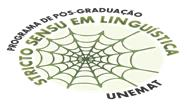Banca de DEFESA: EDNÉIA BENTO DE SOUZA FERNANDES
Uma banca de DEFESA de DOUTORADO foi cadastrada pelo programa.DISCENTE : EDNÉIA BENTO DE SOUZA FERNANDES
DATA : 17/11/2025
HORA: 14:00
LOCAL: Videoconferência
TÍTULO:
TOPONYMY OF THE NEIGHBORHOODS OF GUAJARÁ-MIRIM – BRAZIL–BOLIVIA BORDER – IN A BILINGUAL PERSPECTIVE (LIBRAS AND PORTUGUESE): A FORMAL AND SEMANTIC-MOTIVATIONAL ANALYSIS
PALAVRAS-CHAVES:
bilingual toponymy; Libras; Portuguese; Brazil–Bolivia border; toponymic motivation.
PÁGINAS: 110
GRANDE ÁREA: Lingüística, Letras e Artes
ÁREA: Lingüística
SUBÁREA: Lingüística Aplicada
RESUMO:
This doctoral research, developed within the Graduate Program in Linguistics at the State University of Mato Grosso (UNEMAT), under the research line Studies of the Processes and Social Practices of Language, aims to analyze the toponyms of the neighborhoods of Guajará-Mirim (Brazil–Bolivia border) from a bilingual perspective (Libras and Portuguese), considering their formal and motivational dimensions. Framed within the field of Onomastics, particularly in the subarea of Toponymy, this investigation seeks to understand the relationships between language and culture present in urban naming practices, guided by the following central question: what are the formal and semantic-motivational characteristics of the toponyms in Libras and in Portuguese that name the neighborhoods of Guajará-Mirim, a city located on the border between Brazil and Bolivia? The study is theoretically grounded in Dick (1990, 1992), Sousa (2019, 2022, 2023), Quadros (2019), and Taub (2001), articulating principles of Toponymy and Iconicity in Libras. It is a basic research of qualitative nature and descriptive-explanatory character. Data collection was carried out from two main sources: (i) the urban map of Guajará-Mirim, from which the set of Portuguese toponyms was extracted; and (ii) the Dicionário de Libras – Pedagogia e Letras – Librando channel (YouTube), which provides the signs corresponding to the neighborhood names in Libras. The results indicated that the toponymic motivations differ between the two languages. In Libras toponyms, a strong influence of written Portuguese was observed, manifested in the use of handshapes referring to the initial letters of the names, revealing a process of linguistic contact. In Portuguese toponyms, religious motivations were predominant, evidencing historical and cultural values strongly linked to colonization and the Catholic tradition in the Amazon region. Regarding structure, both Portuguese and Libras toponyms were found to be mostly simple in form. The analysis also revealed that the toponymic signs in Libras are not mere lexical translations of the Portuguese names, but symbolic reconfigurations that integrate processes of visualization, iconicity, and bilingualism, highlighting the linguistic and cultural agency of the local Deaf community. It is concluded that the naming of Guajará-Mirim’s neighborhoods, in both languages, reflects not only linguistic and structural aspects but also the sociocultural and identity dynamics that characterize the Brazil–Bolivia border region. Thus, this research contributes to studies on Toponymy in bilingual contexts and to the recognition of Libras as a language of toponymic expression, broadening the understanding of the relationship between language, space, and culture in border territories.
MEMBROS DA BANCA:
Presidente - 466.104.133-04 - ALEXANDRE MELO DE SOUSA - UFAC
Interna - 80737005 - JOCINEIDE MACEDO KARIM
Interno - 020.853.382-67 - RODRIGO DE SANTANA SILVA -
Externo à Instituição - ANDRÉ NOGUEIRA XAVIER - UFPR
Externo à Instituição - BRUNO GONÇALVES CARNEIRO - UFTO



